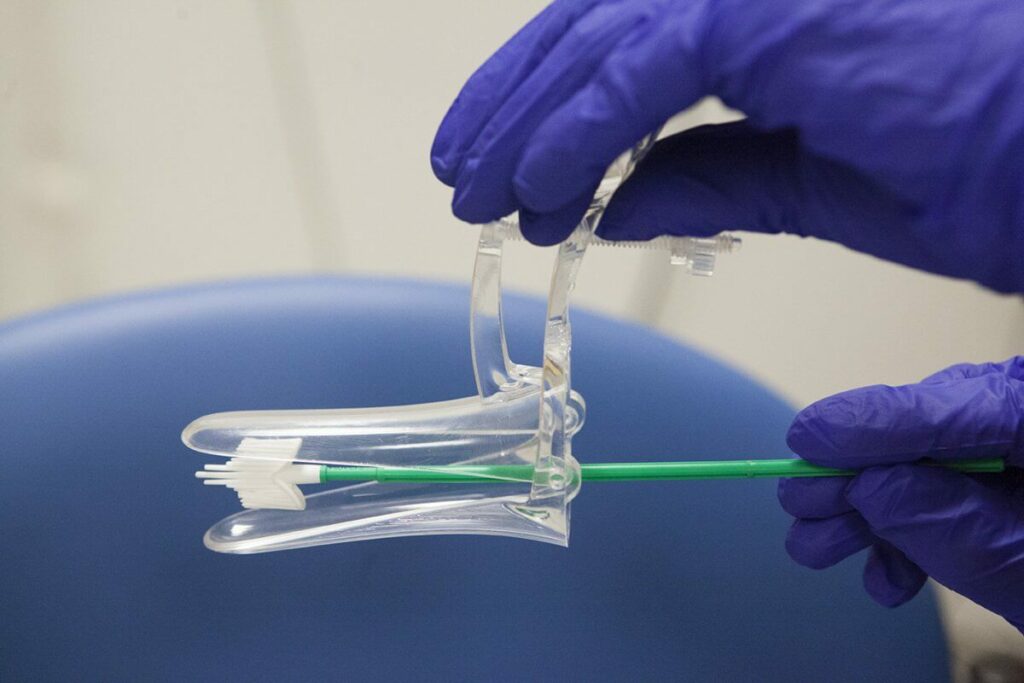WHAT IS A SMEAR TEST?
A cervical smear test is a screening test that women are invited for to help prevent cervical cancer. It is not a test to diagnose cancer. The aim of the test is to pick up early changes in the cells of the cervix (the neck of the womb) that could lead to cancer in the future.
Early detection is the most important step in cancer prevention. If pre-cancerous cells are detected from a smear test, investigations and medical treatments can be started to halt the progression to cancer; which is life-saving. So smear tests can only be a good thing!
WHO IS CALLED FOR A SMEAR TEST?
- First invitation for screening in the UK is at age 25.
- Routine recall (repeat screening test):
- UK: three-yearly tests from age 25 to age 49. Five-yearly tests from age 50 to 64. Screening stops at age 65.
- Women over 65 years of age should be screened if:
- They have not had a cervical screening test since the age of 50.
- A recent cervical screening test has been abnormal.
- Cervical screening does not stop simply due to age until a woman with a previously abnormal cervical screening test has had three negative results.
Many people ask me in my GP practice why smear tests are only started from the age of 25 and not earlier. This is the information I give on this subject based on current national guidelines:
This decision was made by a panel of experts who looked at all the evidence. Their main reasons are:
- Cervical cancer is extremely rare in women under 25 years of age.
- Abnormal cervical screening test results are very common in women under the age of 25. Many of these changes seen revert back to normal without any treatment.
- Cervical screening in much younger women may do more harm than good. Women may be very anxious and worried about abnormalities that eventually go away anyway. Also, there is the potential for harm to occur, as these women might end up being over-treated. This would mean removing cells from the cervix earlier than was needed, perhaps without waiting for the problems to go away by themselves.
WHAT HAPPENS DURING A SMEAR TEST?
Many women feel apprehensive leading up to a smear test. Many worry it may be painful, complicated or are simply embarrassed. As a GP who carries out smear tests and as a woman myself who has had smear tests, I would like to take this opportunity to re-assure you that it is never a bad as you think!
For those of you who have never had a smear test, this is what happens;
- A smear test is carried out by a nurse or doctor.
- They will insert a tiny plastic device called a speculum into the vagina. It is inserted closed and then gently opened so the practitioner can view the cervix.
- A tiny sampling stick with a little brush on the end is to take a gentle “sweep” of the cells on the surface of the cervix.
- This is all that needed for the smear to be taken.
- The speculum is then closed and gently removed in the closed position.
- The brush is then inserted into a sterile pot and special solution to transport the sample to the lab.
- Once in the lab the cells are looked at under the microscope and the findings are reported back to you and your GP.

WHAT ARE THE POSSIBLE RESULTS OF A SMEAR TEST?
The results can be as follows;
- Normal.
- Inadequate.
- Abnormal – of which there are several grades or degrees of abnormality:
- Borderline.
- Mild abnormalities in the cells of the neck of the womb (cervix): mild dyskaryosis.
- Moderate abnormalities in the cells of the cervix: moderate dyskaryosis.
- Severe abnormalities in the cells of the cervix: severe dyskaryosis.
- Possible cancer cells
HUMAN PAPILLOMAVIRUS (HPV)
99 in 100 cases of cervical cancer are positive for the virus HPV. If your test shows mild or borderline changes, it is automatically tested for HPV. If the test for HPV is negative, the chances of developing cervical cancer are extremely low.
Abnormal cells indicate that cancer may develop sometime in the future. About 6 women in 100 will have an abnormal result that requires further testing or treatment. Most of these changes will not lead to cervical cancer.
All of those in the abnormal group sound scary, I know. But it highlights why the smear test is so important to detect early changes before they reach the cancer.
The results that are graded as “abnormal” are fast tracked through to a specialist clinic known as colposcopy for further investigations. In the colposcopy appointment abnormal cells are reassessed by a specialist doctor and a treatment plan is decided which can involve freezing, burning, laser or cutting them away.
If you are called for colposcopy please don’t panic! It is really really important for you to attend the appointment. It doesn’t mean you have cancer. If you have any worries please contact your GP; they will be more than happy to discuss your results with you and explain the next steps to help keep your anxiety to minimum.
SUMMARY
- Cervical smear tests are a use to screen for cervical cancer
- Not to diagnose cervical cancer
- Women are called from the age of 25
- The test is simple, quick, mostly pain-free and not embarrassing!
- The results can be;
- Normal
- Inadequate
- Abnormal
- The results can also be confusing so please don’t hesitate to discuss with your GP
- Please don’t miss your smear test or your colposcopy appointment if you are called for one
- It is never as scary as you think!

Dr Jane Leonard is a fully qualified GP and Cosmetic doctor, graduating from the University of Manchester. She also has a first class honours degree in anatomical sciences, in which she focused her studies on the anatomy of the face, head and neck.
She completed her aesthetic training on Harley Street following a stint at The Alfred Hospital Medical Research Centre, in Melbourne, Australia. Her work in Dermatology research has been published in the prestigious Australasian Journal of Dermatology.
Almost a decade of aesthetic treatment experience, Dr Leonard has been nominated for the Cosmetic Doctor of the Year in the prestigious Safety in Beauty Diamond Awards.















